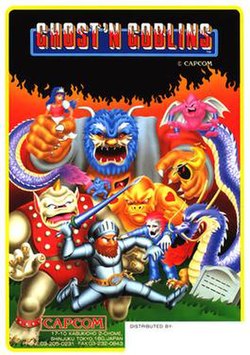Ghosts 'n Goblins (video game)
| Ghosts 'n Goblins | |
|---|---|
 Promotional flyer for the original arcade version of Ghosts 'n Goblins | |
| Developer(s) | Capcom |
| Publisher(s) | Capcom |
| Designer(s) | Tokuro Fujiwara |
| Platform(s) | Arcade, NES, ZX Spectrum, Amiga, Amstrad CPC, Atari ST, IBM PC, Commodore 64, Commodore 16, WonderSwan, Game Boy Color, Game Boy Advance, Virtual Console, PSP |
| Release | September 19, 1985 |
| Genre(s) | Platform game |
| Mode(s) | Up to 1 or 2 players, alternating turns |
Ghosts 'n Goblins (魔界村, Makaimura, lit. "Demon World Village") is a platform arcade game by Capcom, famous for its difficulty. Released in 1985, it was ported to numerous home computer platforms and followed by three official sequels: Ghouls 'n Ghosts, Super Ghouls 'n Ghosts, Ultimate Ghosts 'n Goblins and several spin-offs including Gargoyle's Quest, Demon's Crest and Maximo: Ghosts to Glory.
Gameplay
Ghosts 'n Goblins is a platform game where the player controls a knight, named Arthur, who must defeat zombies, demons and other undead creatures in order to rescue a princess. Along the way the player can pick up new weapons, bonuses and extra suits of armor that can help in this task. The game is often considered very difficult by arcade standards and is commonly regarded as one of the most difficult games released for the NES.[citation needed]
Lives
The player starts out with three lives, and is awarded an extra life when the player reaches 20,000 and 70,000 points. A further life is awarded at every 70,000 points after that, though these settings could be changed using the DIP switches. Two hits from an enemy attack will result in a life being lost. After the first hit, Arthur is reduced to his briefs. A second hit turns him into a skeleton. At the start of each level, Arthur is dressed in full armor whether or not he had armor at the end of the previous level. At certain points in the game, Arthur can suffer instant death whether he is suited in his armor or not.
If the player loses a life, he is returned to the start of the level, or the halfway point if he has managed to get that far. Furthermore, each life can only last a certain length of time (generally around three minutes), the clock being reset at the start of a level. If the clock does run out, the player instantly loses that life.
Differences between versions
- At the sixth level, Ghosts 'n Goblins (U.S. version) features two Giant Cyclops, while Makaimura (Japanese version) has only one. However, in this stage, Makaimura features five devils (Red Arremer), whereas Ghosts 'n Goblins has only three.
- The boss devil flies towards the player slower in Makaimura.
- Ghosts 'n Goblins has a shield as its most powerful weapon, while Makaimura has a cross.
- In Makaimura the player has more time to finish the levels.
Ports
Many conversions to home computers were produced by Elite Systems.
Commodore 64
The Commodore 64 version, released in 1987, featured compelling gameplay. Programmed by Chris Butler, it is also known for its excellent music by Mark Cooksey. Due to the limited resources on the Commodore 64, it was somewhat different than the arcade version. It only featured the Graveyard and Forest, The Ice Palace, The Floating Platforms and Firebridge and The Caves in that order. The player also started the game with five lives. The demon that kidnapped the princess replaces Astaroth in the title screen. Additionally, the cyclops (or "Unnicorn") is the boss of levels one to three, and the dragon is the final boss.
Commodore Amiga
A version for the Commodore Amiga was released in 1990. While the advanced hardware (for the time) of the Amiga allowed an almost arcade-perfect conversion, it failed to emulate the success of the Commodore 64 version. The player started the game with six lives and no music was present unless the Amiga was equipped with at least 1 Megabyte of RAM. The standard configuration of an Amiga 500 was 512 Kilobytes.
Other platforms
Ghosts 'n Goblins was also ported to the Sinclair ZX Spectrum, Amstrad CPC 464/6128, Atari ST, IBM PC, Commodore 16, Sharp X68000, Nintendo Game Boy Color, Game Boy Advance and the NES.
The NES version was developed by Micronics. This version also serves as the basis for the Game Boy Color version, which features passwords. The NES version was also re-released for download for Wii's Virtual Console service on December 10, 2007.
The original arcade version of the game was also included in the compilation Capcom Generations Vol.2: Chronicles of Arthur for the PlayStation (in Japan and Europe) and Sega Saturn (in Japan only), which also contained Ghouls 'n Ghosts and Super Ghouls 'n Ghosts. The three games (based on their Capcom Generation versions) were later collected as part of Capcom Classics Collection.
This game, along with its sequel, Ghouls 'n Ghosts, is available for play on GameTap.
There is a short Ghosts 'n Goblins mini-game included in SNK vs. Capcom: Match of the Millenium for the Neo Geo Pocket Color.
Reception
Ghosts 'n Goblins was rated the 129th best game made on a Nintendo System in Nintendo Power's Top 200 Games list.[1]
References
- ^ "NP Top 200", Nintendo Power, vol. 200, pp. 58–66, February 2006.
External links
- Ghosts 'n Goblins at the Killer List of Videogames
- Template:StrategyWiki
- Ghosts 'n Goblins (video game) at MobyGames
- The Ghosts 'n Goblins The game Ghosts 'n Goblins
- Category at ODP
- Ghosts 'n Goblins at Arcade-History
